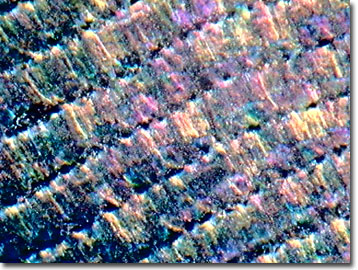Butterfly Wing Scale Digital Image Gallery
Palla ussheri Butterfly
Although they have no common name, Palla ussheri butterflies are not a forgettable species. These members of the brush-footed butterfly family Nymphalidae are an exotic display of color and grace. Their large wingspans colored burnt orange and black can be occasionally glimpsed soaring through the skies of sub-Saharan Africa.

Two subspecies represent Palla ussheri, each featuring hind wings with small false eyespots and short sword-like tail extensions. Broad white vertical bands on the upper and lower sides of the wings are a key characteristic that distinguishes these butterflies from others cohabiting with them in the tropical forests of Africa. The species, however, demonstrates moderate sexual dimorphism. The white stripes of the female are wider and the bands of the male are restricted to the forewings. The undersides of the wings of both sexes are mostly charcoal gray, black, and white, although females are typically paler. The monochrome wing patterns provide Palla ussheri with some security from potential predators by providing camouflage to them while they are at rest in the low-light forest, where scotopic vision is dominant.
The black and orange colors of their upper wing surfaces indicate that Palla ussheri are either unpalatable or edible but mimic other distasteful species. Vanilla plants are the primary host and food plants of Palla ussheri larvae. The plants contain sap, which can cause severe allergic reactions such as itching, skin rashes, and inflammation. Vanillin is also known to cause headaches and gastric troubles in exposed humans. Therefore, it is likely that the voracious caterpillars ingest and sequester defensive compounds from their food plants, as do many other larval lepidopterans. If so, the adult Palla ussheri would be noxious, as the warning coloration of their wings seems to indicate.
Vanilla, the only orchid that is a climbing vine, is an important cash crop in Central Africa. As the preferred food plant of the butterfly larvae, Palla ussheri caterpillars are placed in the unenviable position of being considered agricultural pests. Although the beautiful adult butterflies are a valuable commodity when sold commercially and represent a non-consumptive natural resource that draws ecotourism dollars to local economies, traditional vanilla farmers apply potent pesticides to kill the bothersome larvae. Their native habitat, however, is fairly secure since vanilla crops are highly dependent on a healthy forest canopy for shade and plant health.
Contributing Authors
Cynthia D. Kelly, Shannon H. Neaves, Laurence D. Zuckerman, and Michael W. Davidson - National High Magnetic Field Laboratory, 1800 East Paul Dirac Dr., The Florida State University, Tallahassee, Florida, 32310.
BACK TO THE BUTTERFLY WING SCALE IMAGE GALLERY
BACK TO THE DIGITAL IMAGE GALLERIES
Questions or comments? Send us an email.
© 1995-2025 by Michael W. Davidson and The Florida State University. All Rights Reserved. No images, graphics, software, scripts, or applets may be reproduced or used in any manner without permission from the copyright holders. Use of this website means you agree to all of the Legal Terms and Conditions set forth by the owners.
This website is maintained by our
Graphics & Web Programming Team
in collaboration with Optical Microscopy at the
National High Magnetic Field Laboratory.
Last Modification Friday, Nov 13, 2015 at 01:19 PM
Access Count Since January 21, 2003: 9297
Visit the website of our partner in introductory microscopy education:
|
|
